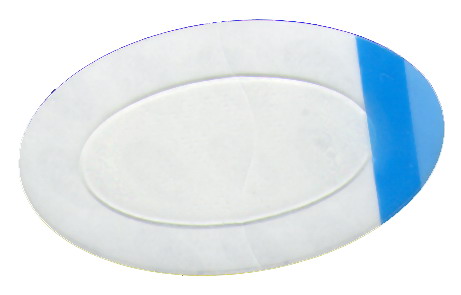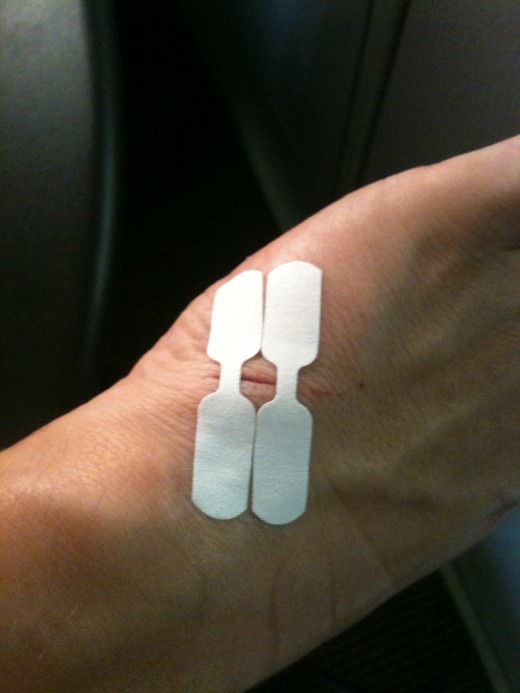Adhesive bandage on:
[Wikipedia]
[Google]
[Amazon]
An adhesive bandage, also called a sticking plaster, medical plaster, or simply plaster in
 The backing and bag are often made of
The backing and bag are often made of

British English
British English (BrE, en-GB, or BE) is, according to Oxford Dictionaries, "English as used in Great Britain, as distinct from that used elsewhere". More narrowly, it can refer specifically to the English language in England, or, more broadl ...
, is a small medical dressing used for injuries not serious enough to require a full-size bandage
A bandage is a piece of material used either to support a medical device such as a dressing or splint, or on its own to provide support to or to restrict the movement of a part of the body. When used with a dressing, the dressing is applie ...
. They are also known by the genericized trademarks of Band-Aid (as "band-aid" or "band aid" in Australia, Canada, India and the US) or Elastoplast (in the UK).
Function
The adhesive bandage protects the wound and scab from friction, bacteria, damage, and dirt. Thus, the healing process of the body is less disturbed. Some of the dressings have antiseptic properties. An additional function is to hold the two cut ends of the skin together to make the healing process faster.Design
An adhesive bandage is a small, flexible sheet of material which is sticky on one side, with a smaller, non-sticky, absorbent pad stuck to the sticky side. The pad is placed against the wound, and overlapping edges of the sticky material are smoothed down so they stick to the surrounding skin. Adhesive bandages are generally packaged in a sealed,sterile
Sterile or sterility may refer to:
*Asepsis
Asepsis is the state of being free from disease-causing micro-organisms (such as pathogenic bacteria, viruses, pathogenic fungi, and parasites). There are two categories of asepsis: medical and surgi ...
bag, with a backing covering the sticky side; the backing is removed as the bandage is applied. They come in a variety of sizes and shapes.
Materials
 The backing and bag are often made of
The backing and bag are often made of coated paper
Coated paper (also known as enamel paper, gloss paper, and thin paper) is paper that has been coated by a mixture of materials or a polymer to impart certain qualities to the paper, including weight, surface gloss, smoothness, or reduced ink absor ...
, but may be made of plastic.
The adhesive sheet is usually a woven fabric, plastic ( PVC, polyethylene
Polyethylene or polythene (abbreviated PE; IUPAC name polyethene or poly(methylene)) is the most commonly produced plastic. It is a polymer, primarily used for packaging ( plastic bags, plastic films, geomembranes and containers including b ...
or polyurethane
Polyurethane (; often abbreviated PUR and PU) refers to a class of polymers composed of organic units joined by carbamate (urethane) links. In contrast to other common polymers such as polyethylene and polystyrene, polyurethane is produced from ...
), or latex
Latex is an emulsion (stable dispersion) of polymer microparticles in water. Latexes are found in nature, but synthetic latexes are common as well.
In nature, latex is found as a milky fluid found in 10% of all flowering plants (angiosperms ...
strip. It may or may not be waterproof; if it is airtight, the bandage is an occlusive dressing
An occlusive dressing is an air- and water-tight trauma medical dressing used in first aid. These dressings are generally made with a waxy coating so as to provide a total seal, and as a result do not have the absorbent properties of gauze pads. ...
. The adhesive is commonly an acrylate, including methacrylates and epoxy
Epoxy is the family of basic components or cured end products of epoxy resins. Epoxy resins, also known as polyepoxides, are a class of reactive prepolymers and polymers which contain epoxide groups. The epoxide functional group is also co ...
diacrylates (which are also known as vinyl resins).
The absorbent pad is often made of cotton
Cotton is a soft, fluffy staple fiber that grows in a boll, or protective case, around the seeds of the cotton plants of the genus '' Gossypium'' in the mallow family Malvaceae. The fiber is almost pure cellulose, and can contain minor pe ...
, and there is sometimes a thin, porous-polymer coating over the pad, to keep it from sticking to the wound. The pad may also be medicated with an antiseptic solution. In some bandages, the pad is made of a water-absorbing hydrogel
A hydrogel is a crosslinked hydrophilic polymer that does not dissolve in water. They are highly absorbent yet maintain well defined structures. These properties underpin several applications, especially in the biomedical area. Many hydrogels ar ...
. This is especially common in dressings used on blisters, as the gel acts as a cushion.
Some people have allergies to some of these materials, particularly latex
Latex is an emulsion (stable dispersion) of polymer microparticles in water. Latexes are found in nature, but synthetic latexes are common as well.
In nature, latex is found as a milky fluid found in 10% of all flowering plants (angiosperms ...
and some adhesives.
Colors
Due to being widely available only in a standard color, some people with skin tones darker than the standard bandage color have expressed frustration at having to use bandages that looked less conspicuous on the skin of fairer-skinned people. This has led to greater support for pharmaceutical companies that manufacture these bandages in a variety of skin tones. Some bandages, especially those designed for children, may come in a wide variety of colors or may feature cartoon characters. Special bandages are used by food preparation workers. These are waterproof, have strong adhesive so they are less likely to fall off, and are usually blue so that they are more clearly visible in food. Some include a metal strip detectable by machines used in food manufacturing to ensure that food is free from foreign objects.Variants

Transdermal patch
A transdermal patch is a medicated adhesive patch that is placed on the skin to deliver a specific dose of medication through the skin and into the bloodstream. An advantage of a transdermal drug delivery route over other types of medica ...
es are adhesive bandages with the function to distribute medication through the skin, rather than protecting a wound.
Butterfly closures, also known as butterfly stitches, are generally thin adhesive strips which can be used to close small wounds. They are applied across the laceration in a manner which pulls the skin on either side of the wound together. They are not true sutures, but can often be used in addition to, or in place of actual sutures for small wounds. Butterfly stitches can be advantageous in that they do not need a medical professional to be placed or removed, and are thus a common item in first aid kits.
Notable brands
* Band-Aid * Curad * Elastoplast * NexcareSee also
*Dressing (medical)
A dressing is a sterile pad or compress applied to a wound to promote healing and protect the wound from further harm. A dressing is designed to be in direct contact with the wound, as distinguished from a bandage, which is most often used to ho ...
References
External links
*{{commons category-inline, Adhesive bandages Medical dressings 20th-century inventions